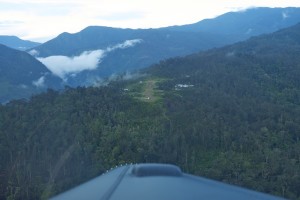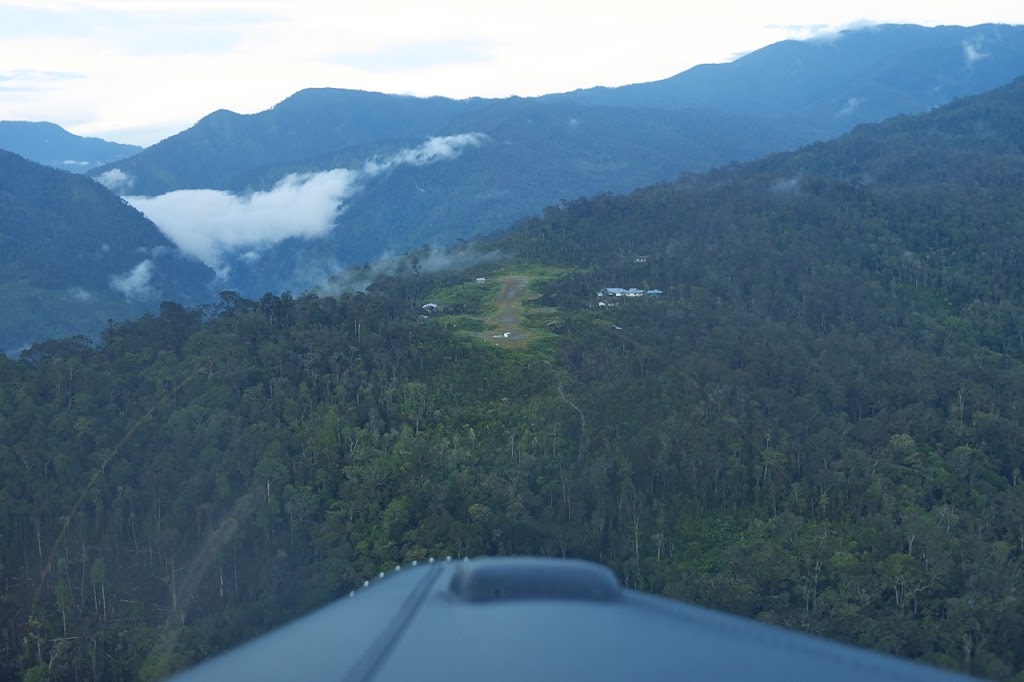 |
| Nabia approach |
A large proportion of the airstrips we go to from Nabire are located along what’s called the “Freeway”. This is a track running roughly south-east/north-west along the valley between Nabire on the northern coast and Mulia airstrip in the central mountain ranges. Along the route are various reporting points that were established by the original missionary pilots and are still used by everyone today.
 |
| PAC P-750 XSTOL over-taking me along the “Freeway” |
One of the main hazards you might encounter along the Freeway are aircraft flying at the wrong level. It’s amazing some commercial pilots still don’t know how to use the quadrantal rule which is the same here in Indonesia as it is in the UK when flying VFR. Radio silence is another one which can be compounded when some operators opt not to have their transponders serviceable, so that my TCAS system can’t see them. First you see of them is an aircraft passing below/overhead, or a little closer before you spot it…
 |
| Old and new |
My two weeks in Nabire was cut a little short due to having to take the Porter based there to our maintenance facility for it’s 100 hour check. All our Porters are inspected by our engineers every 100 hours which tend to come up every 3 weeks or so. Unfortunately, the engineers found some pretty serious corrosion below the floor which was caused by something leaking from cargo some time before. It’s bad enough that the aircraft is now grounded until it can be repaired properly.
 |
| Bilau approach |
I was expecting things to be fairly quiet here in Timika but thankfully it’s as busy as usual thanks to the never ending need to get cargo flown into the mountains. The majority of the flying in Timika is locally subsidised routes for the local people. The contract for these routes expired, as it always does, at the end of December. For reasons best known to Indonesians, they opt to renegotiate the contracts during the month of January and thus there are no subsidised routes being flown. This happens countrywide in Indonesia, every year. Why can’t they negotiate them in November, before they expire and thus save wasting January? I just can’t get my head around it!
 |
| You’d be amazed how accurate they are with those things |
Discover more from Matt Dearden
Subscribe to get the latest posts sent to your email.

Hello Matt
“Unfortunately, the engineers found some pretty serious corrosion below the floor which was caused by something leaking from cargo some time before. It’s bad enough that the aircraft is now grounded until it can be repaired properly.”
what is the PC-6 ?
for information, I am currently completing an article for my blog on all Pilatus PC-6 operated in Indonesia since 1964
alain
Hi Alain,
Not sure I understand what you mean by “what is the PC-6?”? Were you looking for more information about operators of PC-6s in Indonesia? Markus has a good list on his website here: http://www.pc-6.com/porterakt.htm#Indonesia
Hey Matt,
Great to read another post mate. Hope you are well and that the flying remains good. The weather over here in the UK is poor with most if not all of the country covered in snow, so not much chance of me hitting the skies for a while. Quick question through. When you spoke about the quadrantal rule, did you mean when flying IFR and not VFR? Not trying to be a smart ass, as I’m still learning my instrument rating, but I didn’t think the quadrantal rule applied when flying VFR? Just interested.
Anyway stay safe mate, and happy flying!! 😉
Jon
Hi Jon,
It’s been a while since I did any serious flying in the UK but I think you’re quite correct in saying there’s no requirement to fly quadrantals if VFR below the transition altitude. Above that you should be on flight levels if I remember correctly and fly as per the quadrantal rule. Either way, it’s good practice and safer than bumbling around at 3000ft like every other light aircraft!
Hi Matt,
Thanks for the information. That’s how I understand it to be also. But it’s always good to get the views of more experianced pilots like yourself to make sure I’ve got the understanding correct.
Jon